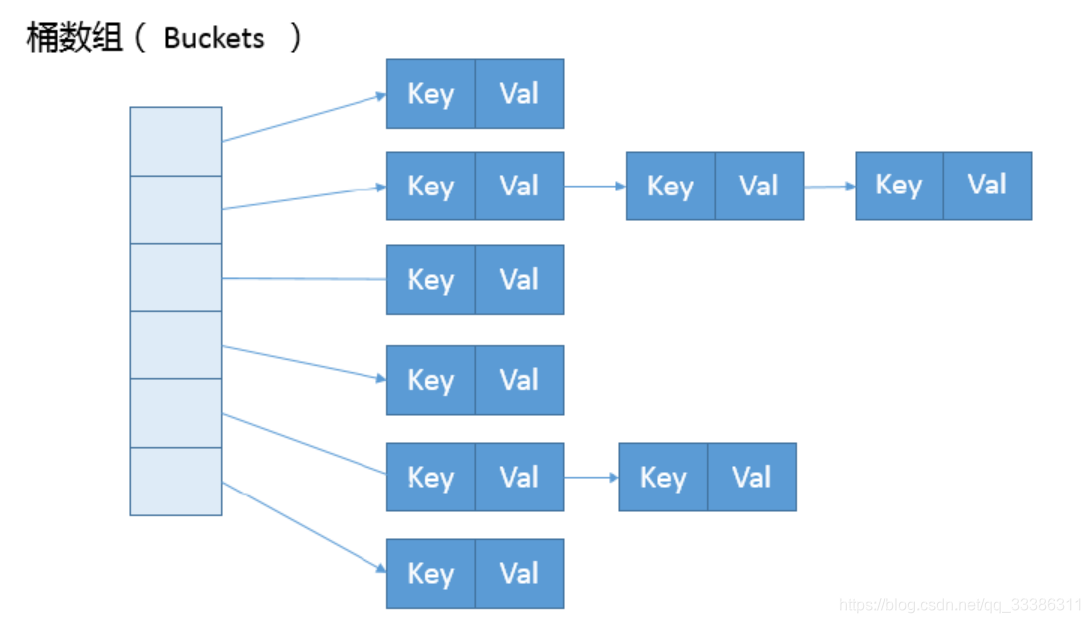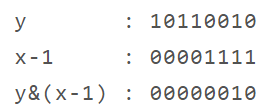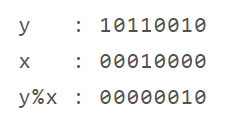存储结构
JDK1.8前是数组+链表,JDK1.8之后是数组+链表+红黑树。本文分析基于JDK1.8源代码。
HashMap的基础结构是Node ,它存着hash、键值对,Node类型的指针next。
主干是桶数组,链表bin用于解决hash冲突,当链表的Node超过阈值(8),执行树化操作,将该链表改造成红黑树。
图片来源:Java核心技术36讲
初始化
HashMap有4个构造器,其他构造器如果用户没有传入initialCapacity (容量)和loadFactor(负载因子)这两个参数,
会使用默认值 ,initialCapacity默认为16,loadFactory默认为0.75。
基于lazy-load原则,主干数组table的内存空间分配不在初始化中,而是在put中。
public HashMap(int initialCapacity, float loadFactor) {
if (initialCapacity < 0)
throw new IllegalArgumentException("Illegal initial capacity: " +
initialCapacity);
if (initialCapacity > MAXIMUM_CAPACITY)
initialCapacity = MAXIMUM_CAPACITY;
if (loadFactor <= 0 || Float.isNaN(loadFactor))
throw new IllegalArgumentException("Illegal load factor: " +
loadFactor);
this.loadFactor = loadFactor;
this.threshold = tableSizeFor(initialCapacity);
}
put
public V put(K key, V value) {
return putVal(hash(key), key, value, false, true);
}
final V putVal(int hash, K key, V value, boolean onlyIfAbsent,
boolean evict) {
Node<K,V>[] tab; Node<K,V> p; int n, i;
//如果数组为空,resize为数组分配存储空间
if ((tab = table) == null || (n = tab.length) == 0)
n = (tab = resize()).length;
//插入位置未被占用,直接创建节点。p是链表头节点
if ((p = tab[i = (n - 1) & hash]) == null)
tab[i] = newNode(hash, key, value, null);
//插入位置已存在数据,则选择覆盖或插入
else {
Node<K,V> e; K k;
//与头结点p相等
if (p.hash == hash &&
((k = p.key) == key || (key != null && key.equals(k))))
e = p;
//链表已树化,执行树节点插入
else if (p instanceof TreeNode)
e = ((TreeNode<K,V>)p).putTreeVal(this, tab, hash, key, value);
else {
//未树化,沿着链表查找是否有跟要插入的key相等的节点
for (int binCount = 0; ; ++binCount) {
//不存在,则插入链表尾
if ((e = p.next) == null) {
p.next = newNode(hash, key, value, null);
//链表节点超过阈值,执行树化
if (binCount >= TREEIFY_THRESHOLD - 1) // -1 for 1st
treeifyBin(tab, hash);
break;
}
if (e.hash == hash &&
((k = e.key) == key || (key != null && key.equals(k))))
break;
p = e;
}
}
if (e != null) { // existing mapping for key
V oldValue = e.value;
if (!onlyIfAbsent || oldValue == null)
e.value = value;
afterNodeAccess(e);
return oldValue;
}
}
++modCount;//保证并发访问时,若HashMap内部结构发生变化,快速响应失败,抛出异常
//插入后,如果元素个数超过size门限,则扩容
if (++size > threshold)
resize();
afterNodeInsertion(evict);
return null;
}
null处理
HashMap 允许插入键为 null 的键值对。但是因为无法调用 null 的 hashCode() 方法,也就无法确定该键值对的桶下标,
只能通过强制指定一个桶下标来存放。HashMap 使用第 0 个桶存放键为 null 的键值对。
确定数组下标
//这是一个神奇的函数,用了异或,移位等运算来保证最终获取的存储位置尽量分布均匀
static final int hash(Object key) {
int h;
return (key == null) ? 0 : (h = key.hashCode()) ^ (h >>> 16);
}
为什么要做异或运算?
主要目的是使hash结果平均化,因为有些数据计算出的哈希值差异主要在高位,而HashMap的哈希寻址是忽略容量以上高位的(取模),这样就可以避免哈希碰撞。
插入
//未树化,沿着链表查找是否有跟要插入的key相等的节点
for (int binCount = 0; ; ++binCount) {
//不存在,则插入链表尾
if ((e = p.next) == null) {
p.next = newNode(hash, key, value, null);
//链表节点超过阈值,执行树化
if (binCount >= TREEIFY_THRESHOLD - 1) // -1 for 1st
treeifyBin(tab, hash);
break;
}
if (e.hash == hash &&
((k = e.key) == key || (key != null && key.equals(k))))
break;
p = e;
}
resize
resize有两个职责:
- 初始化存储数组table
- 容量不足时扩容
几个重要字段
//实际存储的key-value键值对的个数 transient int size; //size门限 int threshold; //负载因子,代表了table的填充度有多少,默认是0.75 final float loadFactor; //用于快速失败,由于HashMap非线程安全,在对HashMap进行迭代时,如果期间其他线程的参与导致HashMap的结构发生变化了(比如put,remove等操作),需要抛出异常ConcurrentModificationException transient int modCount;
final Node<K,V>[] resize() {
//旧table数组的镜像
Node<K,V>[] oldTab = table;
int oldCap = (oldTab == null) ? 0 : oldTab.length;//容量
int oldThr = threshold;//size门限
int newCap, newThr = 0;
if (oldCap > 0) {
//原有容量超过最大容量
if (oldCap >= MAXIMUM_CAPACITY) {
threshold = Integer.MAX_VALUE;
return oldTab;
}
//旧数组容量的两倍小于最大容量,且数组容量大于默认容量
else if ((newCap = oldCap << 1) < MAXIMUM_CAPACITY &&
oldCap >= DEFAULT_INITIAL_CAPACITY)
newThr = oldThr << 1; // double threshold
}
//新数组的容量调整为旧数组的size门限
else if (oldThr > 0) // initial capacity was placed in threshold
newCap = oldThr;
else { // zero initial threshold signifies using defaults
newCap = DEFAULT_INITIAL_CAPACITY;
//size门限值 = 负载因子 * 容量
newThr = (int)(DEFAULT_LOAD_FACTOR * DEFAULT_INITIAL_CAPACITY);
}
if (newThr == 0) {
float ft = (float)newCap * loadFactor;
newThr = (newCap < MAXIMUM_CAPACITY && ft < (float)MAXIMUM_CAPACITY ?
(int)ft : Integer.MAX_VALUE);
}
threshold = newThr;
@SuppressWarnings({"rawtypes","unchecked"})
Node<K,V>[] newTab = (Node<K,V>[])new Node[newCap];
table = newTab;
//一般情况下,容量*2,负载因子不变,则size门限值*2
//将旧的数据移到新的数组
if (oldTab != null) {
...略
}
return newTab;
}
扩容可以归纳为:
- 一般情况下,门限值 = 负载因子 * 容量
- 门限值以倍数调整 newThr = oldThr << 1
- 扩容后,要把旧数组的元素重新放入新数组
容量初始化:
由于频繁扩容影响效率,所以初始化HashMap时要选择好初始容量,要大于预估元素数量/负载因子,且为2的幂数。
负载因子:
负载因子小于1,目的是减少哈希碰撞,默认值0.75一般不需要修改。
树化
fnal void treeifyBin(Node<K,V>[] tab, int hash) {
int n, index; Node<K,V> e;
if (tab == null || (n = tab.length) < MIN_TREEIFY_CAPACITY)
resize();
else if ((e = tab[index = (n - 1) & hash]) != null) {
//树化改造逻辑
}
}
当binCount(链表中节点个数)大于TREEIFY_THRESHOLD时,执行树化逻辑。
如果容量小于MIN_TREEIFY_CAPACITY,只会进行简单的resize。如果容量大于MIN_TREEIFY_CAPACITY ,则会进行树化改造。
get
通过key值返回对应value,如果key为null,直接去table[0]处检索。
key(hashcode)-->hash-->取模,找到对应位置table[i],再查看是否有链表,遍历链表,通过key的equals方法比对查找对应的记录。
final Node<K,V> getNode(int hash, Object key) {
Node<K,V>[] tab; Node<K,V> first, e; int n; K k;
if ((tab = table) != null && (n = tab.length) > 0 &&
(first = tab[(n - 1) & hash]) != null) {
if (first.hash == hash && // always check first node
((k = first.key) == key || (key != null && key.equals(k))))
return first;
if ((e = first.next) != null) {
if (first instanceof TreeNode)
return ((TreeNode<K,V>)first).getTreeNode(hash, key);
do {
if (e.hash == hash &&
((k = e.key) == key || (key != null && key.equals(k))))
return e;
} while ((e = e.next) != null);
}
}
return null;
}
为什么HashMap中equals()和hashCode()要同时重写?
equals()未重写:equals()继承自Object,未重写时其作用与==相同,只判断比较对象存储的值是否相等,当比较对象是引用时,若引用地址相同则返回true,否则,即使两个对象存储的内容是一样的(逻辑上是相等的),依然返回false。
重写后:通过自定义,使某些值逻辑上相等也会返回true,只有引用地址不同且存储内容不同时,才返回false。
hashcode()重写前:Object 对象的 hashCode() 方法会根据不同的对象生成不同的哈希值,默认情况下为了确保这个哈希值的唯一性,是通过将该对象的内部地址转换成一个整数来实现的。
重写后:hashcode 就不再是默认的对象内部地址了,而是自己定义的一个值,保证逻辑上相等。
使用hashcode的目的:相比equlas,它是一种粗粒度的比较,且速度较快。用于初步筛选,当hashcode不同时,其存储内容一定不同,就不需要用equals比较了。
hashcode与equals的基本约定:
- equals相等,则hascode一定相等
- 两者必须同时重写
两者同时重写,并不准确,应该说重写了equlas就一定要重写hascode,否则会出问题。参考https://www.cnblogs.com/skywang12345/p/3324958.html
这是为了保证,当equals返回true时,hashcode一定相同。当hashcode相同时,equals不一定返回true。
如果不同时重写
下面的例子重写了equals,但没重写hashcode。
import java.util.HashMap;
public class Test {
private static class Person{
int id;
String name;
public Person(int id, String name) {
this.id = id;
this.name = name;
}
@Override
public boolean equals(Object o) {
if (this == o) {
return true;
}
if (o == null || getClass() != o.getClass()){
return false;
}
Person person = (Person) o;
//两个对象是否等值,通过id来确定
return this.id == person.id;
}
}
public static void main(String []args){
HashMap<Person,String> map = new HashMap<Person, String>();
Person p1 = new Person(1,"张三");
Person p2 = new Person(1,"张三");
map.put(p1,"一班");
//get取出,从逻辑上讲应该能输出“一班”
System.out.println("结果:"+map.get(p2));
}
}
上述代码返回null。对于重写的equals,p1 和 p2 是相等的,但因为没有重写hashcode,导致get时出现问题。再看一下get的代码,需要hashcode相同且key逻辑上相同。本例中虽然key p1 和 p2的equals返回true,但由于hashcode未重写,导致get失败。
if (e.hash == hash &&
((k = e.key) == key || (key != null && key.equals(k))))
为何HashMap的数组长度一定是2的次幂?
获取数组下标要对h取模。
n = (tab = resize()).length; tab[i = (n - 1) & hash]
h & (length-1)等价于 h % lenght,但是位运算操作比取模运算代价小。
如令 x = 1<<4,即 x 为 2 的 4 次方
y 与 x-1 做与运算,其作用是将y的前4位清零,结果与 y 对 x 取模相同

判断是否存在相同key的节点
//判断是否已经存在
if (p.hash == hash &&
((k = p.key) == key || (key != null && key.equals(k))))
上文已提到,hash是hashcode(key)后经过一些列移位操作的结果,如果两个Entry的hash相同且key的equals()返回true(逻辑上相等),则用新的覆盖旧的。
线程安全
hashmap是非线程安全的,jdk1.7版本的hashmap在多线程并发扩容时,有可能会形成循环链表,再次插入链表会陷入死循环。同时,jdk1.8版本中,会因为其他原因陷入死循环,因为hashmap本来就不是卖你想多线程的,如有需要还是使用ConcurrentMap。
参考
https://zhuanlan.zhihu.com/p/21673805
https://www.cnblogs.com/chengxiao/p/6059914.html
《Java核心技术36讲》 杨晓峰
来源:https://www.cnblogs.com/ChengzhiYang/p/12402615.html